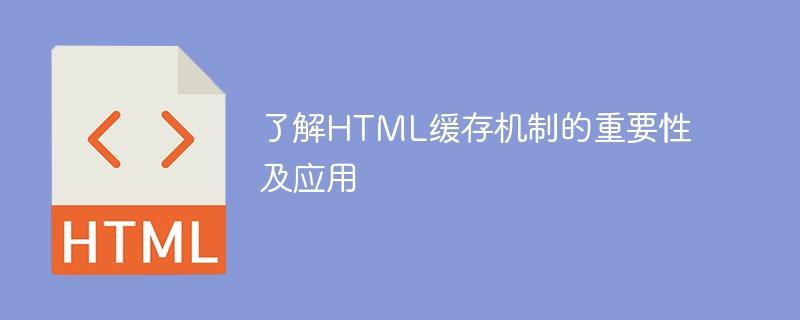Home >Web Front-end >HTML Tutorial >Understand and apply the importance of HTML caching mechanism
Understand and apply the importance of HTML caching mechanism
- 王林Original
- 2024-01-23 09:58:131356browse

To understand the importance and application of the HTML caching mechanism, specific code examples are needed
The HTML caching mechanism refers to saving the static resources of the Web page in Web development A technology used in the client's cache to reduce the number of server requests and improve page loading speed. By properly applying the HTML caching mechanism, the amount of data transmitted over the network can be effectively reduced, thereby improving the user experience.
The importance of HTML caching is mainly reflected in the following two aspects:
- Improving page loading speed
When a user visits the same website multiple times, if it is needed every time Reloading all static resources from the server will cost a lot of time. Through HTML caching, these static resources can be saved in the client's cache and read directly from the cache on the next visit, which greatly reduces the page loading time and improves the user experience. - Reduce server load
When the server handles a large number of user requests, if the HTML page needs to be regenerated and sent to the client every time, the load on the server will be very high. With HTML caching, the server only needs to generate the HTML page once, save it in the client's cache, and read it directly from the cache the next time it is accessed. In this way, the load on the server will be greatly reduced and the performance and stability of the system will be improved.
Understanding the importance of HTML caching, let’s look at some specific code examples to better understand the application of HTML caching.
- Set HTTP cache
You can control the cache behavior by setting the "Cache-Control" field of the HTTP response header. Common values are: public, private, no-cache and max- age, etc., the example is as follows:
HTTP/1.1 200 OK Cache-Control: public, max-age=3600
- Setting the cache of the HTML page
You can control the cache behavior by setting the meta tag of the HTML page, the example is as follows:
<meta http-equiv="Cache-Control" content="max-age=3600, must-revalidate">
- Set the cache of static resources
You can control the cache behavior by setting the response header of static resources (such as pictures, style sheets, script files, etc.), the example is as follows:
HTTP/1.1 200 OK Content-Type: text/css Cache-Control: public, max-age=86400
In actual development, back-end technologies (such as PHP, Java, Node.js, etc.) and front-end technologies (such as JavaScript, CSS, HTML, etc.) can be combined to achieve a more flexible and complex HTML caching mechanism.
To sum up, understanding the importance and application of HTML caching mechanism is of great significance to improving the loading speed of Web pages and reducing server load. By properly setting the HTTP response header, the meta tag of the HTML page, and the response header of the static resource, you can control the cache, thereby improving the user experience and system performance. In actual development, other technical means can also be combined to further optimize the effect of HTML caching.
The above is the detailed content of Understand and apply the importance of HTML caching mechanism. For more information, please follow other related articles on the PHP Chinese website!

